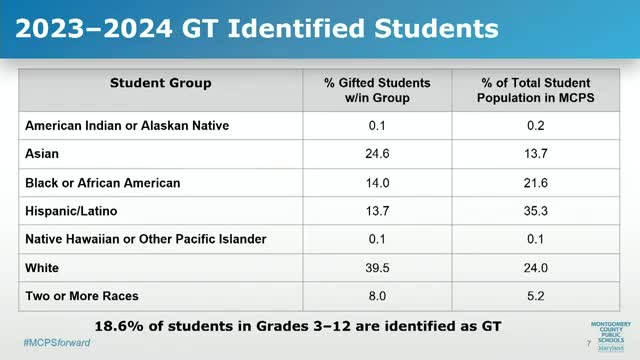School district examines disparities in gifted and talented student identification
May 06, 2025 | Montgomery County Public Schools, School Boards, Maryland
This article was created by AI summarizing key points discussed. AI makes mistakes, so for full details and context, please refer to the video of the full meeting. Please report any errors so we can fix them. Report an error »

The Montgomery County Public Schools Board of Education Committee on Special Populations convened on May 5, 2025, to discuss critical issues surrounding the identification of gifted and talented (GT) students. The meeting focused on recent disaggregated data revealing significant disparities in GT identification among various student demographics.
The presentation began with an overview of the current GT identification statistics, highlighting that the overall identification rate for students in grades 3 through 12 stands at 18.6%. However, the data indicated that historically underserved groups are notably underrepresented. For instance, students identified as two or more races fall 2 percentage points below the mandated 10% identification goal. Hispanic students, who make up 35% of the total student population, have less than 14% identified as GT. In contrast, 40% of white students, who represent 24% of the population, are identified as GT. Asian students account for 14% of the population with 25% identified as GT, while Black students, making up 22% of the population, have only 14% identified as GT.
The data further revealed that economically disadvantaged students, comprising 32% of the population, have only 8% identified as GT, and emergent multilingual learners, who represent 19%, have a mere 0.3% identified as GT. These statistics underscore the need for a reevaluation of the GT identification process.
The committee discussed the necessity of revisiting the criteria used for GT identification, emphasizing the importance of incorporating additional data sources to better serve historically underserved populations. Despite minor adjustments made in previous years, the disparities have persisted. The committee plans to enhance collaboration across offices to develop new criteria aimed specifically at underrepresented groups. They also intend to review resources used in the primary talent development program in Title 1 schools and engage with neighboring school districts to explore effective practices.
The meeting concluded with an invitation for questions, indicating a commitment to transparency and community engagement in addressing these critical issues. The committee's next steps will involve ongoing discussions and collaborative efforts to improve the identification process for gifted and talented students in Montgomery County.
The presentation began with an overview of the current GT identification statistics, highlighting that the overall identification rate for students in grades 3 through 12 stands at 18.6%. However, the data indicated that historically underserved groups are notably underrepresented. For instance, students identified as two or more races fall 2 percentage points below the mandated 10% identification goal. Hispanic students, who make up 35% of the total student population, have less than 14% identified as GT. In contrast, 40% of white students, who represent 24% of the population, are identified as GT. Asian students account for 14% of the population with 25% identified as GT, while Black students, making up 22% of the population, have only 14% identified as GT.
The data further revealed that economically disadvantaged students, comprising 32% of the population, have only 8% identified as GT, and emergent multilingual learners, who represent 19%, have a mere 0.3% identified as GT. These statistics underscore the need for a reevaluation of the GT identification process.
The committee discussed the necessity of revisiting the criteria used for GT identification, emphasizing the importance of incorporating additional data sources to better serve historically underserved populations. Despite minor adjustments made in previous years, the disparities have persisted. The committee plans to enhance collaboration across offices to develop new criteria aimed specifically at underrepresented groups. They also intend to review resources used in the primary talent development program in Title 1 schools and engage with neighboring school districts to explore effective practices.
The meeting concluded with an invitation for questions, indicating a commitment to transparency and community engagement in addressing these critical issues. The committee's next steps will involve ongoing discussions and collaborative efforts to improve the identification process for gifted and talented students in Montgomery County.
View full meeting
This article is based on a recent meeting—watch the full video and explore the complete transcript for deeper insights into the discussion.
View full meeting
